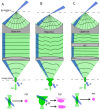Adaptive optics in an oblique plane microscope
- PMID: 39346993
- PMCID: PMC11427218
- DOI: 10.1364/BOE.524013
Adaptive optics in an oblique plane microscope
Abstract
Adaptive optics (AO) can restore diffraction-limited performance when imaging beyond superficial cell layers in vivo and in vitro, and as such, is of interest for advanced 3D microscopy methods such as light-sheet fluorescence microscopy (LSFM). In a typical LSFM system, the illumination and detection paths are separate and subject to different optical aberrations. To achieve optimal microscope performance, it is necessary to sense and correct these aberrations in both light paths, resulting in a complex microscope system. Here, we show that in an oblique plane microscope (OPM), a type of LSFM with a single primary objective lens, the same deformable mirror can correct both illumination and fluorescence detection. Besides reducing the complexity, we show that AO in OPM also restores the relative alignment of the light-sheet and focal plane, and that a projection imaging mode can stabilize and improve the wavefront correction in a sensorless AO format. We demonstrate OPM with AO on fluorescent nanospheres and by imaging the vasculature and cancer cells in zebrafish embryos embedded in a glass capillary, restoring diffraction limited resolution and improving the signal strength twofold.
© 2024 Optica Publishing Group.
Conflict of interest statement
The authors declare no conflict of interest.
Figures







Update of
-
Adaptive Optics in an Oblique Plane Microscope.bioRxiv [Preprint]. 2024 Mar 22:2024.03.21.586191. doi: 10.1101/2024.03.21.586191. bioRxiv. 2024. Update in: Biomed Opt Express. 2024 Jul 09;15(8):4498-4512. doi: 10.1364/BOE.524013. PMID: 38562744 Free PMC article. Updated. Preprint.
References
-
- Stelzer E. H. K., Strobl F., Chang B.-J., et al. , “Light sheet fluorescence microscopy,” Nat. Rev. Methods Primers 1(1), 73 (2021).10.1038/s43586-021-00069-4 - DOI
-
- Davies R., Kasper M., “Adaptive optics for astronomy,” Annu. Rev. Astron. Astrophys. 50(1), 305–351 (2012).10.1146/annurev-astro-081811-125447 - DOI
-
- Booth M. J., “Adaptive optics in microscopy,” Philosophical Transactions of the Royal Society A: Mathematical, Physical and Engineering Sciences 365, 2829–2843 (2007). - PubMed
Associated data
Grants and funding
LinkOut - more resources
Full Text Sources
